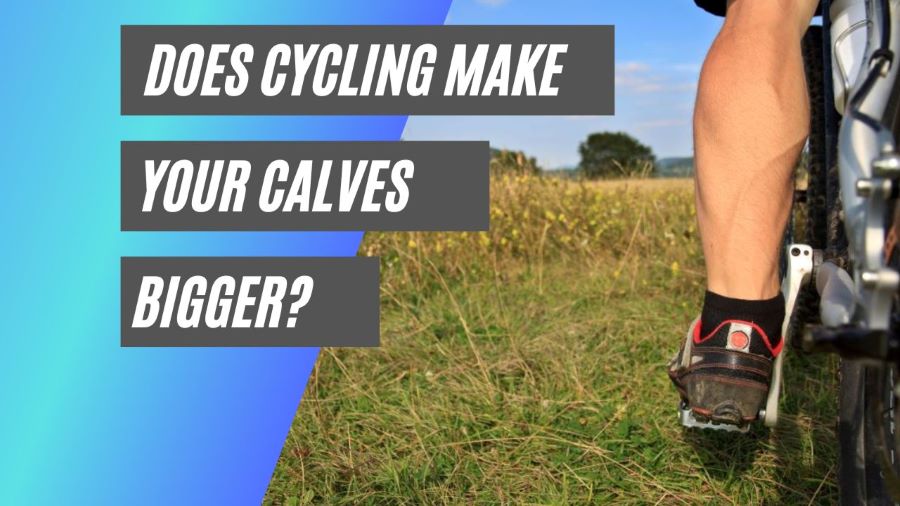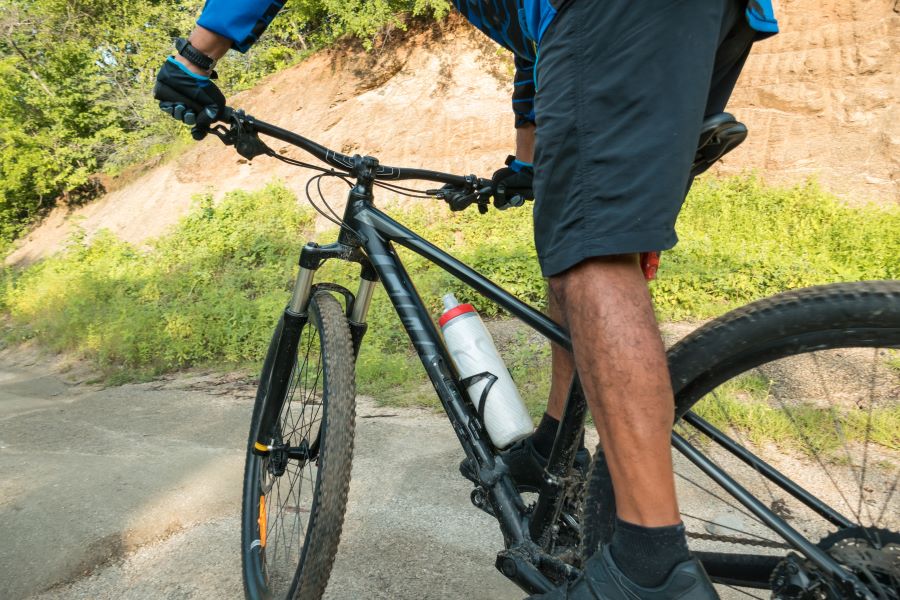This post may contain affiliate links. If you click an affiliate link and make a purchase, I may earn a commission. Also, as an Amazon Associate, I earn from qualifying purchases.--
Cycling definitely helps to define the calves, and you do see many cyclists with big calf muscles. But is cycling able to really make your calves get bigger?
Cycling will help you achieve some toning and muscle development of your calf muscles. This would be heightened if you introduce interval training and climbing into your cycling routine. For optimum calf muscle development, however, weight training is the best option.
Calf growth is definitely something that is possible to an extent with cycling.
In this post, I’ll look at the most important 11 facts that you need to know to use cycling to make your calves bigger.

1. Cycling Tones And Will Build Some Muscle
Probably the crucial thing to know about cycling and calves, is that cycling will definitely tone your calves. It will also probably help you develop a certain amount of muscle, although there will be quicker ways of doing this if this is your optimum goal.
The general aesthetic of your legs and calves will tend to improve through cycling. You will look a little more sculpted, without necessarily going calves like a power-builder.
2. Cycling Acts Like Resistance Training To A Point
How does cycling build muscle?
Well, it acts in the same kind of way as traditional weight resistance training does.
In weight training, muscles exert a force against resistance. For example, your bicep pulls a dumbbell up towards your shoulder doing a bicep-curl. This causes small tears in the muscle fiber, known as micro-tears. These tears rebuild, and the muscle grows.
The muscle is basically trying to adapt to better handle the resistance it had encountered in case it needs to do so again in the future.
Cycling acts in this way also (to a point).
When you pedal, your muscles are exerting a force on the pedals. The resistance of the pedals and the gear you are in is what is acting against your muscles.
Your muscles, and your calf muscle, will be experiencing small micro-tears as they act against the resistance. These rebuild with new muscle fiber and grow the muscle. (Source)
3. The Optimal Micro-Tear To Grow Muscle
However, the amount of resistance in cycling is greatly lower than the optimum to build muscle.
If you think about it, if you went to the gym and lifted weights, the number of reps you are looking at to build muscle in the quickest time is somewhere from 6 to 12 reps.
In general, low numbers of reps against high resistance causes optimum muscle micro-tears.
Of course, it is impossible to cycle against this high resistance. If you only cycled 6 pedal revolutions before being unable to continue, then there must basically be something wrong with your bike, or you’re going up a near-vertical hill!
Cycling is much more about a very high number of repetitions against resistance. Therefore, the amount of micro-tears you receive in your calf muscle is much lower. This will build some muscle, but not as much as weight training.
Here is a table that demonstrates the number of reps (repetitions) of an exercise, and what the target aim is for that number:
| Number Of Repetitions Of An Exercise | Target Aim |
| 1-5 Reps | To increase strength and power, but not necessarily increase muscle size |
| 6-12 Reps | Increase muscle size |
| 12-20 Reps | Increase muscle endurance |
| 20+ Reps | Tone muscle through cardio style resistance |
Some data drawn from nerdfitness.com. (Source)
4. Calves Combine With Quads And Glutes
So how exactly do the calves work in the whole cycling thing?
There are four main muscle groups that are heavily involved in cycling, of which the calves are one. These four are:
- The quadriceps
- The glutes
- The calves
- The hamstrings
In particular, three of these four muscle groups work in unison. They are the quads, glutes, and calves. But how does this happen?
The main force in cycling is the pushing downwards on the down stroke of each pedal revolution. The three
The quads are actually the most important cycling muscle. The quads are located in the front of your thigh. They are the muscle group with the largest muscle mass in your whole body, and they are arguably the most powerful. (Source)
They exert a downward force on the pedals from the top of the pedal revolution to the bottom. The glutes are the large muscle group found in the buttocks. They also act to force the pedals downwards at the same time as the quads.
Both act together with the calves in this repetitive movement.
5. The Role Of Calves In Cycling
The calves are activated for half of the pedal rotation.
They fire up at the top of the pedal rotation, and help push the pedal downwards all the way to the bottom of the rotation.
Then they are at rest during the pedal movement from the bottom to the top of the rotation.
This means that the calves are activated for about half of the rotation, and when one is working the other is at rest.
This of course happens very quickly in reality, so the calves are continually being activated and resting multiple times over the course of a minute.
In general, here are the muscles used in cycling and their importance and function:
| Muscle Group | Role | Impact |
| Calves | Activated from the top of the pedal rotation to the bottom | Medium-High |
| Hamstrings | Pull the leg back upwards from the bottom of the pedal rotation to the top | Medium |
| Quadriceps | Activated from the top of the pedal rotation to the bottom | High |
| Glutes | Activated from the top of the pedal rotation to the bottom | High |

6. Cycling Helps Lose Weight Which Improves The Look Of Your Calves
Cycling is a fantastic way to lose weight, alongside a good-quality dietary plan.
What effect does this have on calves?
Losing excess body fat helps to improve the aesthetic of your muscles. If you lose fat from your legs, your calves will look more toned and sculpted, even if the muscle mass hasn’t increased.
7. Integrate Speed Interval Training Into Your Cycling
If you want to really improve the amount of muscle mass you are developing, then there are a couple of things you can do.
Adding speed interval training into your cycling regime is a good addition. This can add at least 40% more muscle development over the same period, assuming you travel the same distance and for the same amount of time.
What is speed interval training?
Well, it is basically mixing up periods of intense activity and speed with periods of rest. You repeat these ‘intervals’ over a certain time period. (Source)
For cycling, this might look like sprinting for a minute, and then doing a light recovery period of thirty seconds, just cruising with minimal resistance. Continue like this. You can ramp up the intensity of the sprints throughout the ride.
You can adjust all of the following throughout the session:
- The length of the sprints
- The length of the recovery periods
- The intensity of the sprints
8. Try Climbing In Your Cycling To Build Calf Muscles
Proabably the best way to really activate your calves while cycling is to get up out of the saddle. This adds body weight force onto the calves, and also gets them really working to move the body up and down.
If you are outside, this will normally happen naturally when you are cycling up hills. Climbing is traditionally done out of the saddle, as the body weight is needed to keep momentum on the pedals.
If you are cycling indoors on a stationary bike, then this can easily be replicated by turning the resistance up high and getting out of the saddle.
9. Best Cardio For Calves
The best exercises for calves are one where you are going up and down. This jumping on the spot movement is what exercises calves the most.
Cycling is definitely one of the best cardio exercises for calves. It is easy on the ankle and knee joint, both of which are close to the calves, and also it involves some level of the leg going up and down.
Probably the very best cardio exercise for calves is almost certainly using a jump rope.
Simple skipping utilizes this up and down jumping motion, and it means that the calves are completely activated. It provides both strength conditioning and muscular endurance for the calf muscles.
Other good cardio for calves includes:
- Jogging
- Step aerobics
- Hiking
- Going up stairs
10. Some Good Calf Strength Exercises To Build Calf Muscle
If you really want to develop your calf muscles, then weight resistance training is the number one way.
But what are the best exercises? In fairness training your calves is not one of the more straightforward muscle groups to exercise.
Here are some ideas of classic calf exercises to try:
Double Leg Calf Raise
This is probably the most common calf-targeted exercise that you will see in gyms.
In its simplest form, stand facing a wall, with your arms touching the wall when you have your arms stretched out in front of you.
Your toes and ball of your foot now stay in contact with the floor, as you raise up your heels from the ground, keeping your back straight.
You can do this activity with just body-weight, or you can hold dumbbells or larger weights.
Single Leg Calf Raise
If you want to take things up a notch, then try the single leg calf raise. It is basically the same as the double only you do it on one leg.
This doubles the intensity of the load being borne by the leg.
Seated Calf Raise
This is a common machine that you will see in most gyms.
You sit in the seat, with the bar of the machine across your knees. Lift up the bar by raising your heels off the ground, and repeat for about 6-12 reps.
Calf Exercise Video For Inspiration
Here’s a great video on three bodyweight exercises that you can use to grow your calves:
11. You Don’t Feel That Sore Or Stiff After Cycling
One massive bonus about building up your calves through cycling is that you won’t feel anything like as sore or stiff over the days afterwards as you would with weight training.
This goes back to the more limited amount of micro-tears that take place in the calf muscle compared to those when doing strength training.
If you want to keep as active and ready as possible throughout your schedule, then cycling is a good option.
That’s not to mention it’s many other spectacular benefits, such as:
- Increasing sleep
- Being a fantastic form of cardio
- Improving concentration and mental accuity
- Helping weight loss
